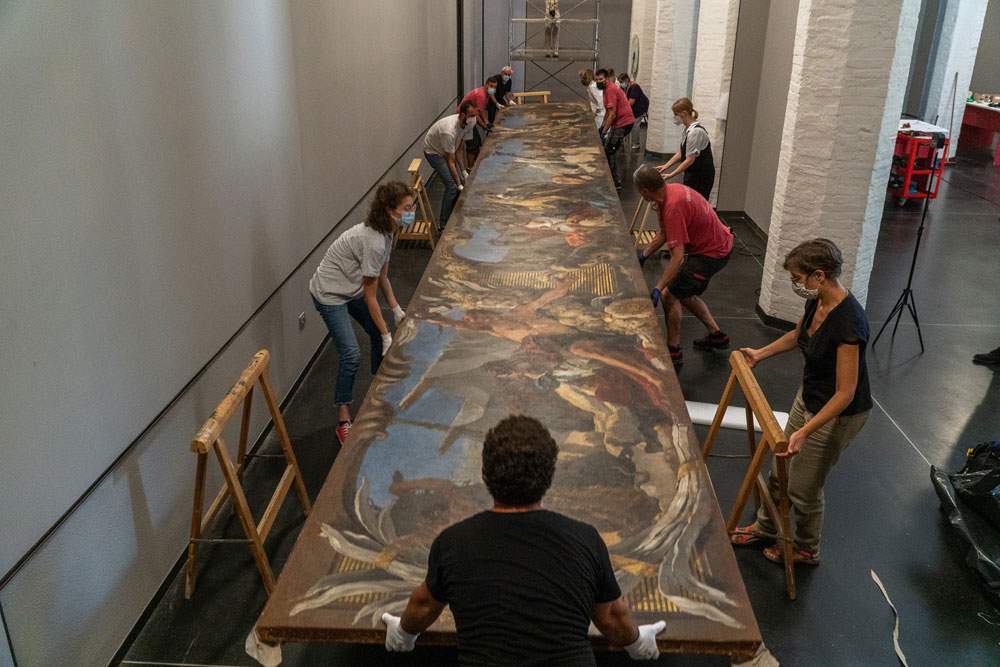The Chastisement of the Serpents, Giambattista Tiepolo ’s monumental, nearly 14-meter-long work, has returned to the Gallerie dell’Accademia in Venice after a delicate restoration supported by Venetian Heritage that lasted about a year. These days, in fact, the delicate operations of taxiing, transporting, unwrapping and setting up one of the most important masterpieces in the collections are taking place, returning to the museum from the Misericordia restoration workshops. All operations will be documented with photos and videos to tell the backstage work behind the handling and setting up of such a large painting: more than 13 meters long by 1 meter 64 meters high.
The work depicts the biblical episode of the snakebite punishment inflicted by God on the people of Israel, guilty of questioning their faith. The Lord’s wrath is appeased by the pleas of Moses who will be instructed to erect a bronze serpent on a log, capable of saving those who would turn their eyes toward him.
The long and narrow format of the canvas is due to its original placement on the “barco,” the pier or hanging chancel from which the cloistered nuns looked out to follow the liturgy, which spanned the full width of the church of Saints Cosmas and Damian on the Giudecca, from which the painting comes.
In order to transport a work of this size, it is necessary to perform a delicate operation, namely taxiing. The canvas, after being disassembled from the frame, is rolled, with the “paint film” exposed, onto a large wooden or polystyrene cylinder, medium to large in diameter, called a roller, equipped with supports at its ends, which allow it to be handled easily and kept suspended from the ground. The painting is protected and then secured to the roller with bands. When rolling it up, it is essential to make sure there are no wrinkles and creases that could compromise the painting. Once at the Galleries, the canvas is unrolled, the frame reassembled into its pieces, and the canvas reassembled on the frame to then be set up.
Coordinating the work is the Galleries’ management team, composed of director Giulio Manieri Elia, deputy director Roberta Battaglia, and restoration managers Cristiana Sburlino and Francesca Bartolomeoli. Two firms were involved in this important operation: the CBC Conservazione Beni Culturali, which carried out the restoration work, and Apice, a company specializing in the transportation of works of art, which is responsible for moving the work by boat.
The restoration, carried out thanks to a grant from Venetian Heritage, remedied severe gaps, mostly vertical and diagonal, that furrowed the entire surface. The damage had been caused by a clumsy folding to which the canvas, disassembled from its frame and rolled up on itself, was subjected for about a century and then placed in a room in the church of Saints Mary and Liberal in Castelfranco, used as a state-owned storage facility.
Tiepolo’s large canvass will be on public view again starting in September, in the new itinerary dedicated to seventeenth- and eighteenth-century painting. This will be alongside other masterpieces of seventeenth- and eighteenth-century Venetian and Venetian painting production and “inserted” into an entire wall of works by Tiepolo.
Image: Giambattista Tiepolo, Chastisement of the Serpents (c. 1732-1734) ©G.A.VE Photo Archive, photo by Joan Porcel - “by permission of the Ministry of Culture - Gallerie dell’Accademia di Venezia.”
 |
| Tiepolo's monumental canvas unrolled: after a year of restoration, it returns to the Gallerie dell'Accademia |
Warning: the translation into English of the original Italian article was created using automatic tools. We undertake to review all articles, but we do not guarantee the total absence of inaccuracies in the translation due to the program. You can find the original by clicking on the ITA button. If you find any mistake,please contact us.